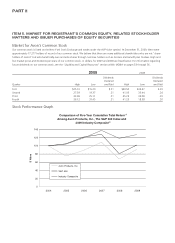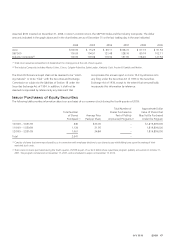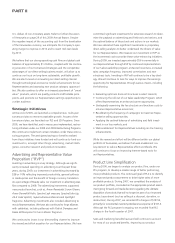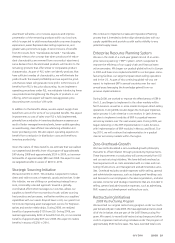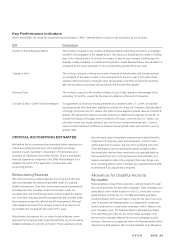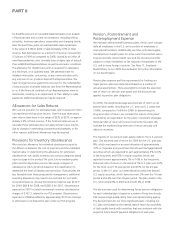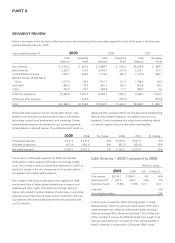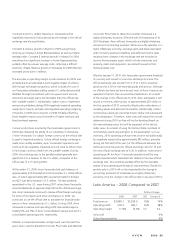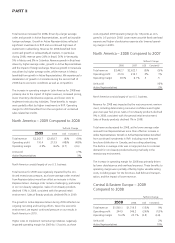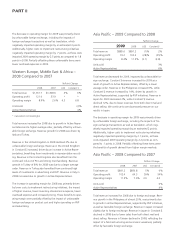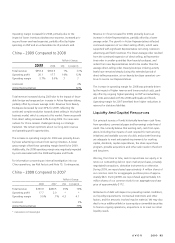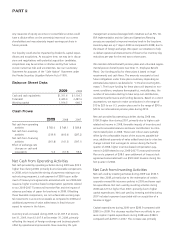Avon 2009 Annual Report Download - page 43
Download and view the complete annual report
Please find page 43 of the 2009 Avon annual report below. You can navigate through the pages in the report by either clicking on the pages listed below, or by using the keyword search tool below to find specific information within the annual report.
The weighted-average discount rate for U.S. and non-U.S. plans
determined on this basis was 5.61% at December 31, 2009, and
6.11% at December 31, 2008. For the determination of the
expected rate of return on assets and the discount rate, we take
into consideration external actuarial advice.
Our funding requirements may be impacted by regulations or
interpretations thereof. Our calculations of pension, postretire-
ment and postemployment costs are dependent on the use of
assumptions, including discount rates and expected return on
plan assets discussed above, rate of compensation increase of
plan participants, interest cost, health care cost trend rates,
benefits earned, mortality rates, the number of associate retire-
ments, the number of associates electing to take lump-sum
payments and other factors. Actual results that differ from
assumptions are accumulated and amortized to expense over
future periods and, therefore, generally affect recognized
expense in future periods. At December 31, 2009, we had pretax
actuarial losses and prior service credits totaling $429.5 for the
U.S. plans and $279.2 for the non-U.S. plans that have not yet
been charged to expense. These actuarial losses have been
charged to accumulated other comprehensive loss within share-
holders’ equity. While we believe that the assumptions used are
reasonable, differences in actual experience or changes in
assumptions may materially affect our pension, postretirement
and postemployment obligations and future expense. During
2008, the plan assets experienced significant losses, which were
mostly due to unfavorable returns on equity securities. These
unfavorable returns will increase pension cost in future periods.
For 2010, our assumption for the expected rate of return on
assets is 8.0% for our U.S. plans and 7.18% for our non-U.S.
plans. Our assumptions are reviewed and determined on an
annual basis.
A50basis point change (in either direction) in the expected
rate of return on plan assets, thediscount rate or the rateof
compensation increases, would have had approximately the
following effect on 2009 pension expense:
Increase/(Decrease) in
Pension Expense
50 Basis Point
Increase Decrease
Rate of return on assets (5) 5
Discount rate (9) 9
Rate of compensation increase 1(1)
Taxes
We record avaluation allowance to reduce our deferred tax
assets to an amount that is more likely than not to be realized.
While we have considered projected future taxable income and
ongoing tax planning strategies in assessing theneed for the
valuation allowance, in the event we were to determine that we
would be able to realize anet deferred taxasset in thefuture, in
excess of the net recorded amount, an adjustment to the
deferred taxasset would increase earnings in the period such
determination was made. Likewise, should we determine thatwe
would not be able to realize all or part of our net deferred tax
asset in thefuture, an adjustment to the deferred taxasset would
decrease earnings in the period such determinationwas made.
Deferredtaxes are not provided on the portion of unremitted
earnings of subsidiaries outside of the U.S. when we conclude
that these earningsare indefinitely reinvested. Deferred taxes are
provided on earnings not considered indefinitely reinvested.
We establish additional provisions for income taxes when,
despite thebelief that our tax positions are fully supportable,
there remain some positions that are likely to be challenged and
may or maynot be sustained on review by taxauthorities. We
adjust these additional accrualsinlight of changing facts and
circumstances. We file incometax returns in many jurisdictions.
In 2010, anumber of income taxreturns are scheduled to close
by statute and it is possible that anumber of taxexaminations
may be completed. If our filing positions are ultimately upheld,
it is possiblethat the2010 provision forincome taxes may
reflect adjustments.
We recognize the benefit of atax position, if that position is
more likely than not of being sustained on audit, based on the
technical merits of the position. We believe that our assessment
of more likely than not is reasonable, but because of the sub-
jectivity involved and the unpredictable nature of the subject
matter at issue, our assessment may prove ultimately to be
incorrect, which could materially impact the Consolidated
Financial Statements.
Share-based Compensation
All share-based payments to employees are recognized in the
Consolidated Financial Statements based on their fair values
using an option-pricing model at the date of grant. We use a
Black-Scholes-Merton option-pricing model to calculate the fair
value of options. This model requires various judgmental
assumptions including volatility, forfeiture rates and expected
option life. If any of the assumptions used in the model change
significantly, share-based compensation may differ materially in
the future from historical results.
AVON2009 25



